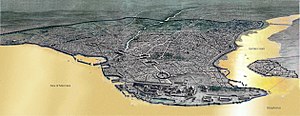 |
| Ice-cream seller, Constantinople, 1898
Constantinople
City
Constantinople was the capital city of the Roman/Byzantine Empire, and also of the brief Latin, and the later Ottoman empires.
Founded: 330 AD
Constantinople (Greek: Κωνσταντινούπολις Konstantinoúpolis or Κωνσταντινούπολη Konstantinoúpoli; Latin:Constantinopolis; Ottoman Turkish: قسطنطینية, Qustantiniyye) was the capital city of the Roman/Byzantine Empire(330–1204 and 1261–1453), and also of the brief Latin (1204–1261), and the later Ottoman (1453–1923) empires. It was reinaugurated in 324 AD at ancient Byzantium, as the new capital of the Roman Empire by Emperor Constantine the Great, after whom it was named, and dedicated on 11 May 330.[5]
From the mid-5th century to the early 13th century, Constantinople was the largest and wealthiest city in Europe[6]and it was instrumental in the advancement of Christianity during Roman and Byzantine times as the home of theEcumenical Patriarch of Constantinople and as the guardian of Christendom's holiest relics such as the Crown of Thorns and the True Cross. After the final loss of its provinces in the early 15th century, the Eastern Roman (Byzantine) Empire was reduced to just Constantinople and its environs, along with Morea in Greece, and the city eventually fell to the Ottomans after a month-long siege in 1453.
Constantinople was famed for its massive and complex defences. Although besieged on numerous occasions by various peoples, the defences of Constantinople proved invulnerable for nearly nine hundred years before the city was taken by foreign forces in 1204 by the Crusader armies of the Fourth Crusade, and after it was liberated in 1261 by the Byzantine Emperor Michael VIII Palaiologos, a second and final time in 1453 when it was conquered by the Ottoman Sultan Mehmed II. The first wall of the city was erected by Constantine I, and surrounded the city on both land and sea fronts. Later, in the 5th century, the Praetorian Prefect Anthemius under the child emperorTheodosius II undertook the construction of the Theodosian Walls, which consisted of a double wall lying about 2 km (1.2 miles) to the west of the first wall and a moat with palisades in front.[7] This formidable complex of defences was one of the most sophisticated of Antiquity and the city was built intentionally on seven hills as well as juxtaposed between the Golden Horn and the Sea of Marmara and thus presented an impregnable fortress enclosing magnificent palaces, domes, and towers, necessitated from being the gateway between two continents(Europe and Asia) and two seas (the Mediterranean and the Black Seas).
The city was also famed for its architectural masterpieces, such as the Greek Orthodox cathedral of Hagia Sophiawhich served as the seat of the Ecumenical Patriarchate, the sacred Imperial Palace where the Emperors lived, the Galata Tower, the Hippodrome, the Golden Gate of the Land Walls, and the opulent aristocratic palaces lining the arcaded avenues and squares. Constantinople had a fifth-century university (University of Constantinople) which contained numerous artistic and literary treasures before it was sacked in 1204 and 1453,[8] including its vast Imperial Library which contained the remnants of the Library at Alexandria and had over 100,000 volumes of ancient text.[9]
Constantinople never truly recovered from the devastation of the Fourth Crusade and the decades of misrule by the Latins. Although the city partially recovered in the early years after the restoration under the Palaiologosdynasty, the advent of the Ottomans and the subsequent loss of the Imperial territories until Constantinople became an enclave inside the fledging Ottoman Empire rendered the city severely depopulated when it fell to the Ottoman Turks,[10] whereafter it replaced Edirne (Adrianople) as the new capital of the Ottoman Empire.
Modern names of the city[edit]
The modern Turkish name for the city, İstanbul, derives from the Greek phrase eis tin polin (εἰς τὴν πόλιν), meaning "into the city" or "to the city".[22] This name was used in Turkish alongside Konstantiniyye, the more formal adaptation of the original Constantinople, during the period of Ottoman rule, while western languages mostly continued to refer to the city as Constantinople until the early 20th century. In 1928, the Turkish alphabet was changed from Arabic script to Latin script. After that, as part of the 1920s Turkification movement, Turkey started to urge other countries to use Turkish names for Turkish cities, instead of other transliterations to Latin script that had been used in the Ottoman times.[23][24][25][26] In time the city came to be known as Istanbul and its variations in most world languages.
The name "Constantinople" is still used by members of the Eastern Orthodox Church in the title of one of their most important leaders, the Orthodox patriarch based in the city, referred to as "His Most Divine All-Holiness the Archbishop of Constantinople New Rome and Ecumenical Patriarch." In Greece today, the city is still called Konstantinoúpolis/Konstantinoúpoli (Κωνσταντινούπολη/Κωνσταντινούπολις) or simply just "the City" (Η Πόλη / Η Πόλις).
|
History always fascinate every one. Its seems amazing even thinking that how any place or person looks like hundreds, thousands or millions years ago. So its more amazing to see old historical pictures. We can see our past through such available old historical pictures.
Saturday, September 3, 2016
Ice-cream seller, Constantinople, 1898
Subscribe to:
Post Comments (Atom)

No comments:
Post a Comment